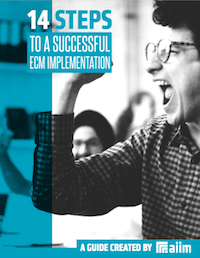The AIIM Blog
Keep your finger on the pulse of Intelligent Information Management with industry news, trends, and best practices.
If you’ve been paying attention to the research we conduct and the educational information we share, you know that AIIM describes Intelligent Information Management (IIM) as all the things you want to do with, or get from, your organization’s information. We break these up into five key categories of actions or aspirations: Creating and Capturing Information Extracting Intelligence from Information Digitalizing Core Business Processes Automating Governance and Compliance Implementing an Information Management Solution
Share
AIIM on Air | Capture and Imaging
Our ability to intelligently capture information in an automated and consistent way, share it with teams, customers and partners, and integrate that content into business processes is a core element of Intelligent Information Management. Indeed, this is the “on-ramp” to the process improvements using information to drive organizational performance.
Share

Making an ECM implementation successful requires planning and attention to detail. The best way to create the right solution is to identify organizational goals and priorities. Learn how to manage a successful implementation in our free guide.
We’ve covered the importance of Information Capture on the blog before and explored how capture represents the first step in the information lifecycle. In this step, we “capture” or gather information into our business ecosystem to store, manage, protect, and ultimately it use for business value. It ALL starts with capture. But, the value of a document is in its content, not whether it was received as an email attachment, captured via a smart phone or tablet, or scanned using a multifunction device. Therefore, multichannel capture takes into account that your business likely has multiple channels or sources of information flowing in and out of your business. As we will discover together, these channels often need to be treated individually, and your Information Capture strategy must take into account the differences from channel to channel.
Share
Many organizations have an obligation to maintain the information they create and receive as part of regular business activities and to ensure that the information is secured and maintained in official filing systems. But, with an endless amount of information flowing in and out of your business on a daily basis - how do you determine what to capture and what to avoid? Not all information is equal, and capturing everything could actually have a more negative impact on your business, but we'll address this later in the post. This post will help you develop an Information Capture strategy that fits your business' needs and avoids the common pitfalls.
Share
Capture and Imaging | Electronic Records Management (ERM)
To succeed on the Digital Transformation journey, requires a strategy, planning, and the design of a better information ecosystem - what we refer to as Intelligent Information Management (IIM). The first step on this journey is to get all of your information into the information ecosystem. This is a practice called Capture. Let’s take a deeper look at this first step of digital transformation.
Share
Have you noticed how information just keeps popping up all over your business? It’s enough to make you feel like this trying to keep up with it all. You solve one issue, only for another to just pop up: via GIPHY Information has to enter the process from somewhere. And knowing where it comes from can make a difference by allowing you to make certain assumptions about that information: its format, its quality, its state of approval, and so on.
Share